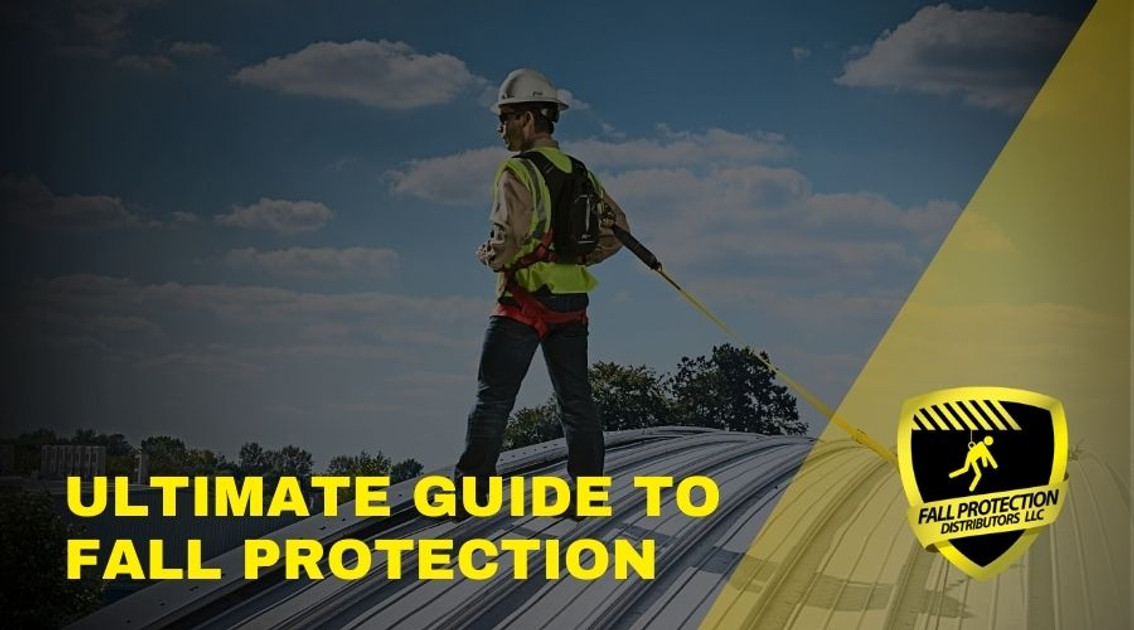Ultimate Guide to Metal Roof Fall Protection
Posted by Howie Scarboro - CEO Fall Protection Distributors, LLC on Feb 15th 2024
Let's Start With the Industry Statistics
Welcome to our essential guide on metal roof safety, where the thrills of working high above the ground meet the sobering realities of occupational hazards. In the construction industry, the statistics speak volumes about the risks involved, especially when it comes to working at heights. In 2020, out of 1,008 construction fatalities, 351 were due to falls to a lower level, as reported by OSHA. This stark figure underscores the imperative need for robust fall protection equipment and training.
The trend over recent years shows that despite advancements in safety technology, the rate of fatal falls has not decreased proportionally. In 2021, the construction industry accounted for nearly 1 in 5 workplace deaths, with over one-third of these fatalities being attributed to falls, slips, and trips. The data also reveals that specialty trade contractors in the private construction sector are most affected, experiencing an increase in fatal falls, slips, and trips from 229 in 2018 to 281 in 2021.
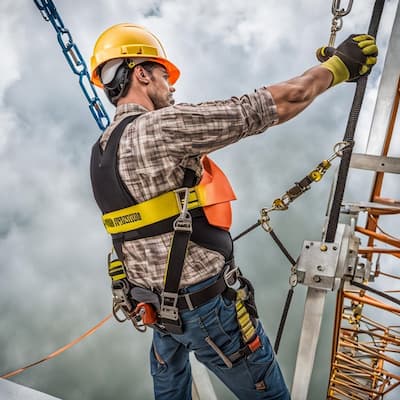
This alarming trend highlights the critical importance of fall protection. It is a stark reminder that every fall is 100% preventable with the right safety measures in place. Our guide aims to provide you with comprehensive insights into the latest fall protection technologies, best safety practices, and effective planning strategies to combat these preventable tragedies.
As we delve into this high-stakes topic, we emphasize the need for heightened awareness, adoption of life-saving measures, and the development of rigorous safety plans that align with OSHA 1926.501 fall protection standards. Let's navigate this world together, ensuring safety is paramount in every metal roofing project. Join us as we embark on this journey to enhance roof safety, armed with knowledge and a commitment to preventing falls.
Why Do We Need Fall Protection On Metal Roofs?
Imagine this: a clear sky, a stunning view from atop a metal roof, and you, feeling like the king of the world. But here's the catch - gravity is still the undefeated champion. That's where fall protection comes in, transforming from a mere safety measure to your lifesaving hero.
Why is this so crucial?
Simply put, today's modern metal roof finishes are designed to be slippery, and the consequences of a fall can be dire. We're not just talking bumps and bruises here – falls from roofs are a leading cause of serious work-related injuries and fatalities. OSHA's not just whistling Dixie with their regulations – they're the voice of reason in a world where overconfidence can have serious repercussions.
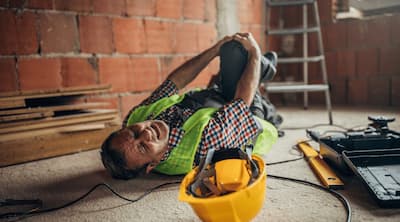
According to the Bureau of Labor Data, falls account for a significant percentage of construction injuries. And with the increasing popularity of metal roofs for their durability and energy efficiency, the risks are only climbing higher.
What Can You Do? 3 Simple Steps
1. Understand And Identify The Risks;
This comes from intensive training on the fall protection rules and regulations that have been carefully crafted to assist you in your quest of zero workplace accidents. Metal roofs present unique challenges due to their material and design, making slipping more likely.
2. Obtain The Best Equipment For The Job
Equip yourself with the right gear for the job and knowledge of how to use that equipment. Fall protection systems aren't just fancy accessories; they're your lifeline.
3. Train The Authorized Users
Now that you have selected the right gear and developed a safety plan to protect the workers from falls, the next task is to train the Authorized Person about the equipment being used, the safety plan for that project, and the rescue plan in case the worst possible scenario does occur. OSHA defines Authorized User as "a person approved or assigned by the employer to perform a specific type of duty or duties or to be at a specific location or locations at the jobsite."

What Are My Options For Fall Protection Systems for Metal Roofs?
Guardrails:
Guardrails are a key component in metal roof safety, providing a sturdy barrier between workers and the roof edge. They offer passive fall protection, meaning they don't require active participation from the worker, making them a safer and easier option than other forms of active protection. Systems like the Falltech 604022 Temporary Guardrail are ideal for edge and parapet work are designed to comply with OSHA standards. These guardrails can be customized to suit unique site needs and are easy to install with a non-penetrating, modular design.
Horizontal Lifelines:
Horizontal lifelines offer a flexible solution, providing security and mobility for workers on metal roofs. They allow for movement across a wide area while still being securely tethered. This system is particularly beneficial on large or complex roof layouts where mobility is a key requirement.
Malta Dynamics HLL3001 4 Person 100' Kernmantle HLL kit is an excellent option for most roof types that require a temporary horizontal lifeline.
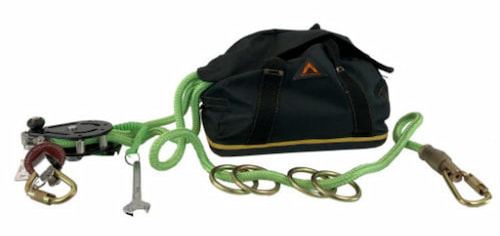
If working on standing seam metal roofs where anchors penetrations are not permitted, you can deploy the SSRA HLL kit that includes the Malta HLL3001 along with SSRA1 Standing Seam Roof Anchors and SSRA3 Anchor Plates for each end of the rope.
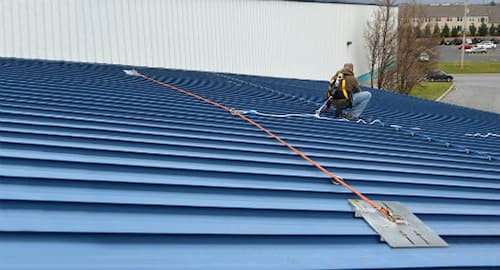
When used on standing seam you will need to limit the number of workers to two on the HLL rope at a time, but additional SSRA1 anchors can be mounted on the seam adjacent to the HLL system for workers to anchor to when performing work in a fixed area.
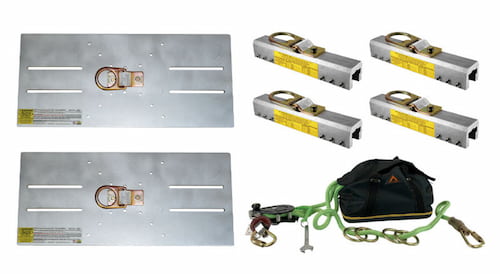
Personal Fall Arrest Systems (PFAS):
PFAS are essential for individual safety on metal roofs. They typically include a harness, lanyard, and an anchor point, ensuring that if a fall occurs, the system will arrest the fall and minimize injury. This "personal bodyguard" is crucial, especially in areas where other forms of fall protection are not feasible.
There are hundreds of styles of harness, anchors, and lanyards available for various purposes. The vast majority of workers need good quality, comfort, reliability and value when selecting the best gear they can afford.
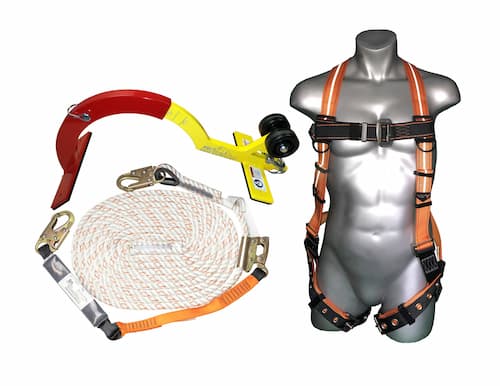
RidgePro:
The RidgePro product is a unique solution that deploys an anchor point by hooking over the roof peak, ensuring 100% tie-off at all times. This is especially useful for steeply pitched metal roofs, providing a secure anchor that's easy to install and move as work progresses along the ridge.
In conclusion, choosing the right fall protection system for a metal roof depends on various factors like the roof type, job duration, and required mobility. It's crucial to select OSHA-compliant systems and ensure they are correctly installed and used. Each of these systems offers a layer of safety that is indispensable in the high-risk environment of metal roofing.
A top selling kit for the average worker would be the RidgePro bundle that includes the RidgePro ridge anchor, Malta Dynamics C7050 50' vertical lifeline with rope grab and shock absorbing lanyard, and Malta B2002 Warthog Harness. This versatile kit allows the average worker to access the roof from the ladder while maintaining 100% tie-off until he returns safely back to the ladder. This kit is hugely popular with solar installers, roof inspectors, Christmas light installers, and maintenance crews.
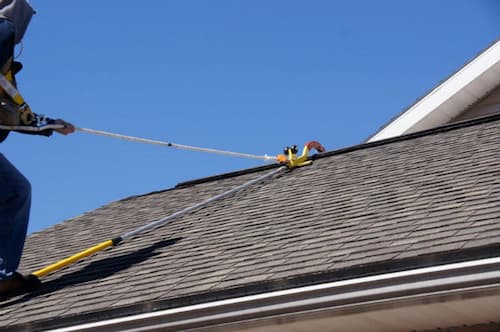
Standing Seam Roof Anchors:
Standing Seam Roof Anchor (SSRA1): The SSRA1 Roof Anchor is a notable option for fall protection on standing seam metal roofs. This innovative product, designed for both homeowners and contractors, offers a secure way to work on standing seam roofs without penetrating the panels. The SSRA1 is engineered to provide superior safety, boasting an impressive load capacity.
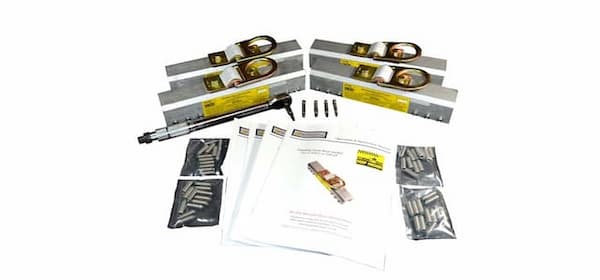
Features and Benefits:
Incredible Load Capacity: The SSRA1 was tested to withstand loads up to 14,500 lbs Ultimate Breaking Strength, significantly exceeding the maximum testing protocol for OSHA and ANSI. This high strength is attributed to its patented structural design and 6 pairs of opposing set screws, an industry exclusive. American made using the highest quality aluminum and stainless steel components.
Non-Penetrating Design: The anchor features a solid 6061-T6 aluminum body with 12 stainless steel set screws, ensuring a secure attachment without damaging the roof panels. It’s a non-penetrating design that maintains the integrity of the roof. Low torque is all that is required for secure attachment unlike other anchors that use round tip set screws that rely on significantly heavier torque settings and seam manipulation to stay in place.
Versatility: The SSRA1 is compatible with a wide range of standing seam profiles, making it a universal solution for various roofing types. Its design allows it to fit t-seams, bulb seams, SnapLok, and more, covering over 500 standing seam panel profiles.
Ease of Installation: Installation is straightforward and can be completed quickly with basic hand tools. The anchor clamps securely to about 95% of today's standing seam roof profiles.
ANSI and OSHA Compliance: Meeting and exceeding important safety standards, the SSRA1 is ANSI ASTM B-117 salt spray tested and OSHA/ANSI tested to 5,000 lbs in all directions of pull.
Low Profile and Aesthetics: Its low-profile attachment to the seam minimizes tripping hazards and is less obtrusive, especially for permanent installations. It can also be powder-coated to color match roofs.
Interchangeable Mounts: The SSRA1 can be used for mounting various devices from different fall protection manufacturers, including roof jacks/walk boards, and horizontal lifelines.
This anchor is a robust and reliable choice for ensuring safety on standing seam metal roofs. It's a perfect blend of strength, versatility, and ease of use, making it a top choice for professionals seeking effective fall protection solutions.
When selecting a fall protection system for a metal roof, it's crucial to consider the specific needs of the project and the compatibility of the system with the roof type. The SSRA1 offers a comprehensive solution, ensuring safety without compromising the roof structure.
How Are Metal Roof Fall Protection Products Load Tested?
When it comes to ensuring the security of fall protection equipment for metal roofs, the process involves rigorous load testing. This is essential to verify that the system can withstand the forces it may encounter during a fall, thereby preventing accidents and ensuring worker safety.
Load Testing and Its Importance:
Load testing is crucial for determining the strength and reliability of fall protection systems. This testing can be categorized into two main types: proof testing and pull testing (also known as strength testing). Proof testing involves calculations and modeling to assess the strength of an anchor point. If an anchorage fails this test, a pull test, which physically applies force to the anchor, may not be necessary. However, care must be taken during pull testing to avoid damaging the anchor, which would then require replacement. Typical 3rd party engineered lab testing will be performed at an accredited ISO 17025 facility.
Professional Verification and Testing:
It's vital that a "qualified person," as defined by OSHA, oversees the design and installation of fall protection systems. This individual should have extensive knowledge, training, and experience in solving problems related to fall protection. Regular inspections by a competent person are also crucial to ensure the ongoing reliability of these systems. They look for any signs of wear, corrosion, or damage that could compromise the system's integrity.
Regular Inspections:
OSHA 1910.140 requires that certain roof anchors, especially those supporting rope descent systems, be inspected annually and certified at least every ten years. However, more frequent inspections may be needed if there's an accident, significant building alterations, or exposure to harsh weather elements. All single point anchors and lifeline systems should be inspected annually by a competent person to remain in compliance.
Compliance Testing:
Fall protection systems should undergo compliance testing every 6 to 12 months, depending on the system and frequency of use. This is essential not only for safety but also for insurance and liability reasons. Non-compliant systems can invalidate insurance and put lives at risk. Carefully read the manufacturer's documentation for inspection requirements.
Key Differences in Fall Protection Systems:
It's important to understand that there are different types of fall protection systems. Fall restraint systems prevent workers from reaching unprotected edges, while fall arrest systems are designed to stop a fall. The choice between these systems often depends on the specific work conditions and requirements.
What Are The Best Practices For Metal Roof Safety?
Addressing Anchorage Challenges: A solid anchorage point is fundamental in any fall protection system for metal roofs. The anchorage must be robust and reliable, as it forms the base of the safety setup. It's important to use approved and well-installed anchor points to avoid the risk of a system failing when it's needed most.
Best Practices for Enhanced Safety:
Use of Non-Slip Boots:
While non-slip boots provide better grip on metal roofs, it's crucial to remember that they should always be used in conjunction with personal fall arrest systems (PFAS). This is because the micro-thin coating of oil often found on metal roof panels can reduce the effectiveness of non-slip boots. A thorough wash of the roof panels can enhance the grip of these boots.
Rope Guards and Stop Blocks:
These components are essential for protecting lifelines from abrasive edges on metal roofs. They act as a final line of defense, ensuring that the main safety system remains intact. For instance, snow guards used in colder regions not only manage snow slides but can also function as stop boards to arrest a fall.
Catch Platforms:
When all other safety measures fail, a catch platform installed close to the roof eaves can minimize fall impact. It's important that these platforms comply with OSHA's Scaffold Standard and are inspected regularly by a competent person.
Panel Platforms and Counter-rigged Lifelines:
For handling bulky roofing materials, panel platforms can be extremely efficient. Additionally, counter-rigged lifelines can offer enhanced maneuverability and protection, especially when working near the edges of a roof.
Training and Awareness:
Proper training is indispensable. For instance, training for specific equipment like Malta Dynamics' "The Grabber", a mobile fall protection system, is crucial to ensure safe and effective use. This includes classroom sessions and hands-on training for best practices and equipment-specific knowledge.
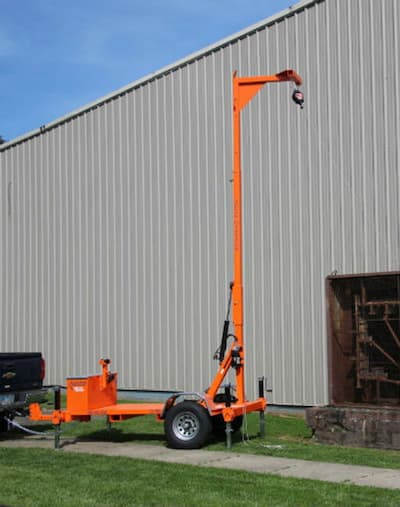
Creating a Safety Culture:
Beyond using the right equipment, fostering a safety-conscious work environment is critical. This involves ensuring that every team member is aware of the risks and adheres to safety rules and procedures.
Regular Inspection and Compliance Testing: Regular inspection of fall protection equipment is essential to ensure its reliability and compliance. This includes checking for wear, tear, or damage that could compromise safety.
In summary, the testing and regular inspection of fall protection systems are critical for ensuring the safety of those working at heights on metal roofs. These procedures verify that the equipment can withstand the necessary forces, ensuring compliance with safety standards and reducing the risk of accidents.
Conclusion: Ensuring Comprehensive Safety on Metal Roofs
As we conclude our exploration into metal roof safety, let's recap the crucial points we've discussed, integrating relevant keywords to enhance our focus on this vital topic.
Importance of Fall Protection on Metal Roofs:
We delved into why robust fall protection is critical, highlighting the alarming statistics from OSHA on falls and fatalities in the construction industry. Emphasizing the necessity of reliable metal roof fall protection systems, we touched upon the risks inherent in working on these surfaces and the pivotal role of safety equipment and compliance.
Diverse Fall Protection Systems for Metal Roofs:
We navigated through various fall protection options like guardrails, horizontal lifelines, personal fall arrest systems (PFAS), and specialized products like the SSRA1 Roof Anchor. This section underscored the significance of selecting the right system based on job specifics, including roof type and work conditions, and emphasized the importance of OSHA-compliant systems.
Load Testing and Regular Inspections for Metal Roof Safety:
Here, we focused on the critical process of load testing for fall protection equipment, underscoring the need for professional verification and regular inspections to ensure ongoing reliability and OSHA compliance. We also highlighted the importance of considering all factors affecting total fall distance in safety planning.
Challenges and Best Practices in Metal Roof Safety:
Lastly, we tackled the challenges in metal roof safety, discussing best practices such as the use of non-slip boots, rope guards, stop blocks, catch platforms, and the need for rigorous training. The section reinforced the concept of creating a culture of safety, where awareness, regular equipment checks, and adherence to safety rules are paramount.
In Conclusion
Our journey through metal roof safety has been comprehensive, addressing the various aspects of fall protection, the importance of choosing the right equipment, the necessity of load testing and inspections, and the best practices for mitigating risks. By embracing these practices, staying updated with the latest safety technologies, and fostering a culture of safety, we can significantly reduce the hazards associated with working on metal roofs.
Remember, whether it's guardrails, horizontal lifelines, personal fall arrest systems, or specialized anchors like the SSRA1, the goal is always the same: ensuring that every worker returns home safely at the end of the day. Safety on metal roofs is not just about compliance; it's about commitment to life and well-being. If you need to consult with a metal roof fall protection safety specialist, contact us at www.standingseamroofanchor.com.

